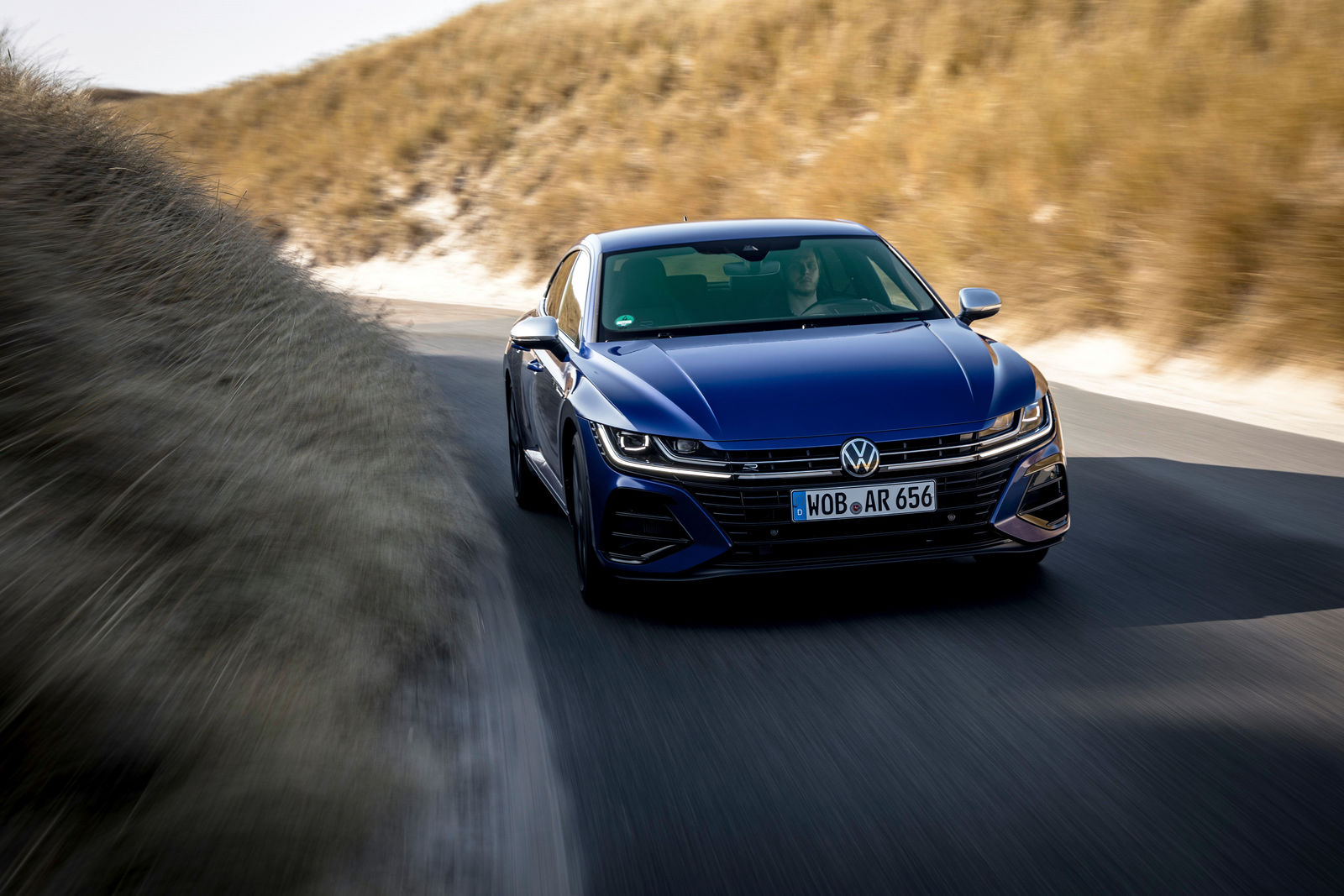Sports running gear plus DCC. The Arteon R and Arteon R Shooting Brake are equipped with a sports running gear and adaptive chassis control DCC as standard. Due to the sports running gear, the bodies of the two R models are lowered by 20 mm. The wheels on the front axle are guided by suspension struts (coil springs with telescopic shock absorbers) and lower wishbones (track-stabilising scrub radius). At the rear, there is a four-link axle with individual wheel suspension, gas-filled shock absorber and separate springs. Both axles are equipped with stabilisers.
Adaptive chassis control. The adaptive chassis control (DCC) continuously reacts to the road surface and driving situation while taking into account steering, braking and acceleration manoeuvres, for example. By means of the set driving profile, the driver can influence the reduction in body motion as desired. The required damping is calculated for each wheel and adjusted at the four shock absorbers within fractions of a second. This ensures that DCC always provides the highest level of driving comfort and ideal driving dynamics in conjunction with the Vehicle Dynamics Manager. The basic settings for the adaptive chassis control can also be adjusted using the driving profile – Comfort, Sport, Race and Individual – and a continuously variable DCC slider (from Comfort+ to Sport+) in the Infotainment system. As explained above, a firm press of the R button on the steering wheel can also directly activate the Race profile.
Comfort, Sport, Race and Individual. In the Race profile implemented especially by Volkswagen R for the Arteon R and Arteon R Shooting Brake, the coasting function (freewheeling without drive power) is deactivated, the engine sound is increased via the exhaust flaps, and the DSG, the DCC, progressive steering and the all-wheel drive system are adjusted to a sportier setup. The Sport profile is the dynamic and ideal basic mode for the R models. The Comfort profile is tailored more for a high level of comfort, while still offering a high degree of steering precision. In the Individual profile, the driver can precisely adjust and save their own driving profile using a digital slider in the Infotainment system. Below Comfort (Comfort+), this results in maximum decoupling of the body for even greater comfort. Above Sport (Sport+), the tuning becomes even more dynamic and very direct; in this case, minimum body movement is combined with maximum agility. Using the ESC button, the driver is also able to deactivate ESC separately while on the race track.
Individual ESC control. When the two 320 PS Arteon models are started, ESC is always active as a full system. However, drivers can adapt the ESC in two stages. In ESC Sport mode, the ESC thresholds and ASR slip thresholds are increased to reduce the intensity of interventions. In ESC Off mode, experienced drivers can additionally deactivate ESC altogether for all driving situations. However, Front Assist and Swerve Assist reactivate the full ESC system in emergencies.
Progressive steering. The Arteon R and Arteon R Shooting Brake are equipped with progressive steering as standard. To be more specific, the ratio in the progressive steering system is more direct than in “normal” electromechanical steering; what’s more, the R models come equipped with a specific software application. How progressive steering works: conventional steering systems operate on the basis of a fixed gear ratio. However, the progressive steering applies a progressive gear ratio. This significantly reduces the effort required to steer when manoeuvring and parking. On winding country roads and when turning off, the driver will notice a greater dynamic response thanks to the more direct setup. It also means that the driver does not have to change their hand position as frequently. In terms of technology, progressive steering is essentially differentiated from the basic steering system by variable steering rack and pinion gearing as well as a more powerful electric motor. In functional terms, this means the following: unlike in systems with a fixed steering ratio, which are always forced to compromise between driving dynamics and comfort, the teeth of the steering rack vary significantly over the range of the steering movement. As a result, the transition between a comfortable steering response in the centre range (driving straight ahead) and direct steering response for larger steering wheel turn angles has been set up progressively to enable a more agile steering response in driving dynamics situations.
18-inch brake system. To make sure the Arteon R models can be braked confidently from their top speed of 270 km/h, the models have been equipped with a new front-axle brake system with 18-inch brake discs. To be more specific, the 18-inch disc brakes in the front measure 357 x 34 mm, while on the rear axle, both gran turismos are decelerated by 17-inch disc brakes (disc dimension: 310 x 22 mm). The brakes themselves are built with pin discs and a brake pot made of aluminium, which reduces the weight by 600 grams on each side. A speed-dependent map in the electromechanical brake servo ensures precise brake control. The brakes respond particularly sensitively when manoeuvring, for example, but bite instantaneously and powerfully at high speeds. Thanks to precise optimisation in the high brake pressure range, the brakes still permit very exact control even just before ABS intervention. A larger brake master cylinder ensures crisp, precise response in combination with sporty and short brake pedal travel. The specific tuning of the brake pedal characteristic also supports this sportier and more direct brake pedal feeling subjectively in the driver’s perception. The new brake system is visually characterised by its blue brake calipers (adorned with a silver R logo in the front).
